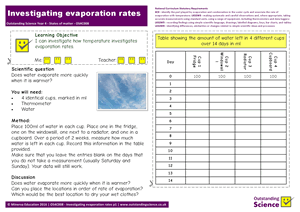

I can research the melting and boiling points of different materials.
Children learn that many materials other than water will melt if heated to a high enough temperature. They carry out a networking activity, where each child has an incomplete set of information, to find out the melting points of 6 different metals, They record their information in a table and transfer it to a bar chart.
I can group substances according to whether they are solid, liquids or gases.
Children learn about the differences between solid, liquids and gases and how they can be identified. They cut out 14 different images of familiar substances and group them as solid, liquids or gases. They discuss which materials were most difficult to group and how temperature can affect whether it is a solid, liquid or a gas.

3 pages
I can explain how materials change state.
Using the particle model, children learn about the different states of matter (solids, liquids, and gases). They learn how the amount of energy that the particles have affects the state of the material. Children use scientific vocabulary (melt, freeze, evaporate, condense) to create a diagram explaining how matter changes state.

3 pages
I can investigate the melting point of different materials.
Children investigate the melting point of 3 familiar materials - ice, chocolate and butter. They use a thermometer to measure temperature and record their results in a table. They discuss how accurate their predictions were and whether melting is a reversible change.

1 page
I can investigate how effective different materials are as thermal insulators.
Children investigate how effective 4 different materials are at insulating a cold drink and slowing its increase in termperature. They use thermometers to measure the temperature of each cup every 15 minutes over the course of 2 hours. Children record their information in a table and then create a line graph showing the temperature of all 4 cups over a 2-hour period.

2 pages
I can explain the water cycle.
Children learn about the water cycle and that water is not created or lost, but simply moved around the Earth. They learn that heat from the Sun drives the water cycle. Children create their own water cycle diagram, explaining the processes of evaporation, condensation and precipitation by cutting and pasting or using their own words.

3 pages
I can make a solar still and explain how it works.
Children learn how to make their own solar still to recover water. They learn that solar heating of water-laden soil causes some water to evaporate, which can then be captured by a plastic sheet where it evaporates and is recovered by a bowl or mug. They explain how the solar still works.

1 page
I can investigate how temperature affects evaporation rates.
Children investigate how rapidly 100ml of water placed in locations with different temperatures will evaporate. Using a table, they record the capacity of 4 different measuring containers over the course of 14 days. They complete a line graph showing the capacity of all 4 containers over that period. They learn how a line graph can help us infer missing results (such as weekend measurements).

2 pages